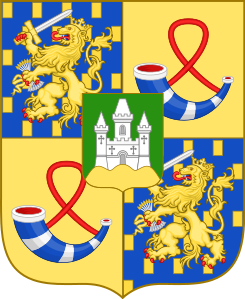This map shows the water board of Krimpenerwaard, the area around Schoonhoven, south of Gouda in the current province of South Holland. See the waterschap blog post to learn more about water boards. The map shows the different polders and streams in the water board's district. The map can help you locate ancestral properties if the polder is noted in land records. Note that the map is oriented with the north at the bottom of the map, as you can see in the compass. The vignette shows that … [Read more...]
Dutch term – Zegel
A zegel is a seal or stamp. In the Middle Ages, it became customary to attach a seal to charters as marks of identity and authority. Originally, seals would often show knights on horses. In the 1100s, this was gradually replaced by coats of arms. The following image shows a combination: Duke John II of Brabant is displayed as a knight on his horse, with his coat of arms on his shield, banner, and horse mantling. For examples of medieval seals, see the earliest generations in my Eleanor of … [Read more...]
Quick tip – Don’t assume that coat of arms is yours
Many people mistakenly believe that finding a coat of arms with your surname means it's "your" coat of arms and that you're entitled to use it. That's not how it works. The coat of arms may have been used by a different family with the same name. You will have to trace your line back to find out if one of your ancestors ever used it. Even that doesn't mean that it's yours to use. For more information, see Ask Yvette - Does my Family have a Coat of Arms? … [Read more...]
Dutch term – Broodzegel
A broodzegel (literally: bread seal) is an old way to seal documents using bread and paper. In the late Middle Ages, smaller wax seals were sometimes covered with paper to help preserve the imprint. Sometimes, bread or dough was used instead of wax. Such a seal would be called a broodzegel. Source: Photo and information from Stadsarchief Rotterdam Facebook post; citing 1-01_2162: Records relating to the case between Gorinchem, Schoonhoven and Rotterdam versus Dordrecht about … [Read more...]
Quick tip – Most people did not have crests
If you're looking for your family crest, you might be disappointed. Most families did not have family crests. If your ancestors were poor farmers and laborers, like the majority of families, they would not have had a family crest. Read more on how to find out if you have a family crest. … [Read more...]
Ask Yvette – Does my family have a coat of arms?
Several people have contacted me wanting to know if they have a coat of arms or family crest. Please keep in mind that the following applies to the situation in the Netherlands; other countries have different rules and uses of coats of arms. Four things to know about coats of arms Most people did not have coats of arms. Most people who used coats of arms, were well-to-do. Often they were nobles, rich merchants (patricians) or administrators. If your ancestor was a poor farmer, chances are … [Read more...]
Dutch term – familiewapen
A familiewapen is a family crest or coat of arms. Most people in the Netherlands did not have a coat of arms. People who used them were usually members of the nobility or other members of the upper class. Working class families did not have a use for a crest. There are several heraldic databases and collections that will tell you whether a coat of arms exists for a particular name. Even if you find a crest for your name, that does not mean that your family ever had any right to use it, as … [Read more...]






